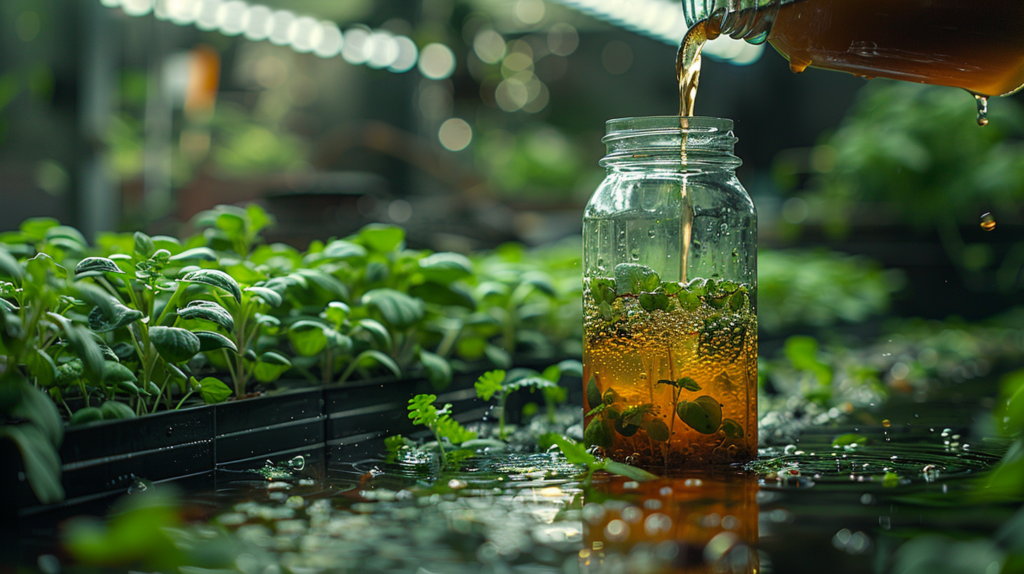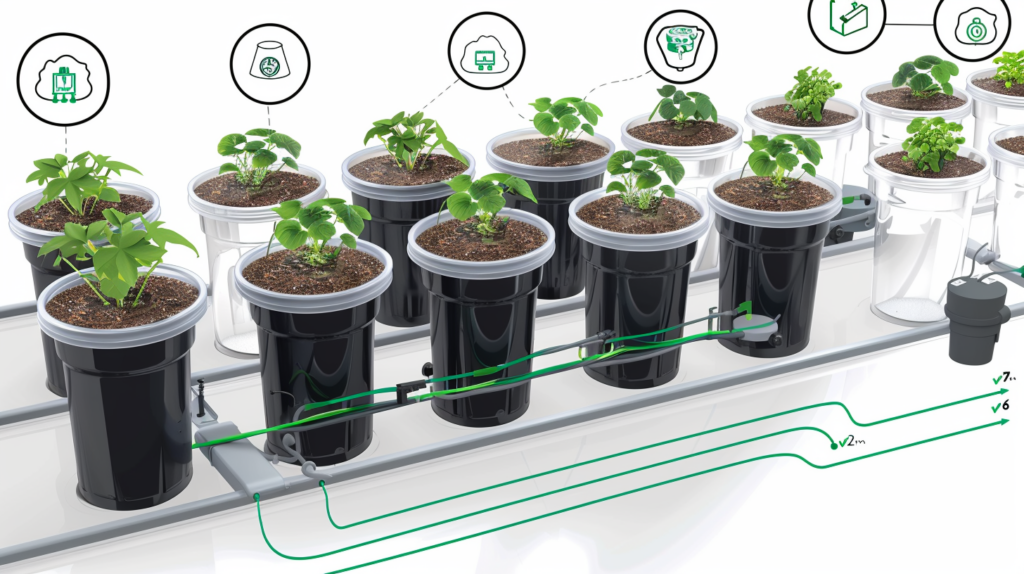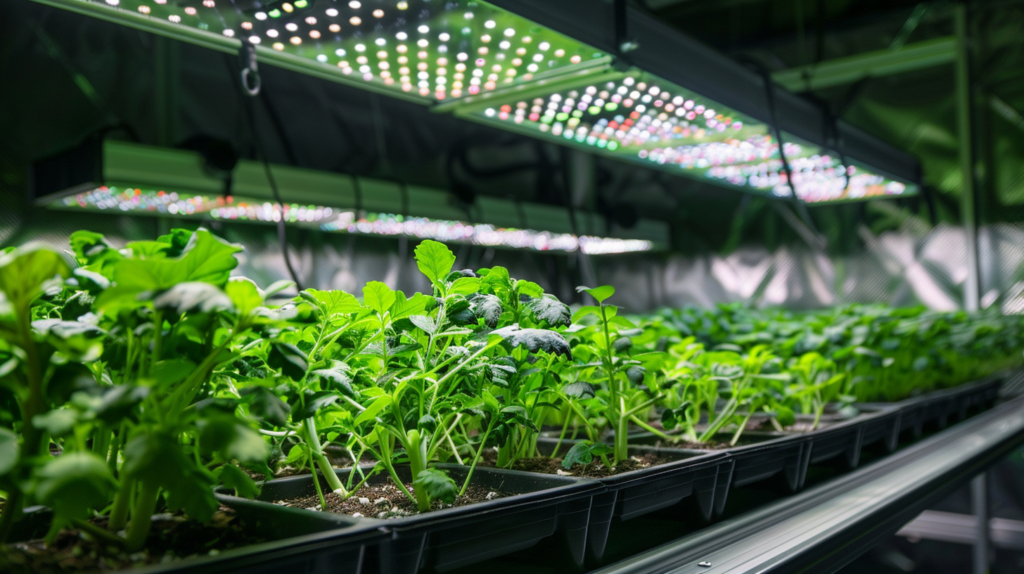Introduction
Hydroponics, the soil-free cultivation method, has surged in popularity for its resource efficiency and sustainability. To further elevate plant vitality and growth within these systems, introducing organic nutrients is key. Compost tea, a concoction brewed from decomposed organic matter, is an organic powerhouse, infusing hydroponic systems with beneficial microbes and vital nutrients.
This guide will walk you through enhancing your hydroponic garden with compost tea, leveraging its organic benefits to promote vigorous plant growth, optimize nutrient absorption, and cultivate a flourishing, eco-friendly hydroponic environment.
Overview of Hydroponics and the Benefits of Using Compost Tea
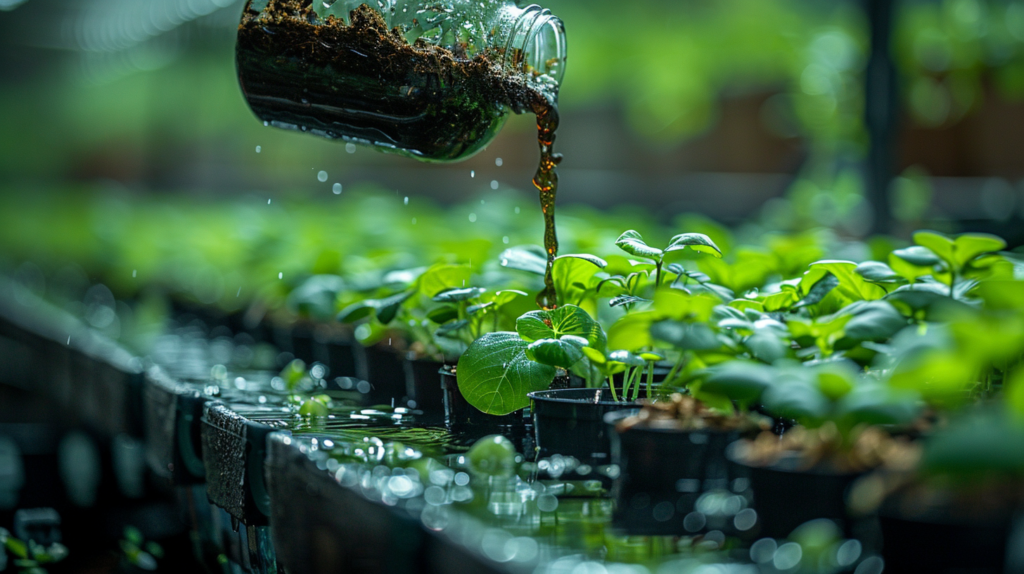
Hydroponics, an innovative farming method, enables plants to flourish in a soil-less environment, relying instead on a nutrient-enriched water solution. This approach boasts several benefits, such as optimized space utilization, significant water savings, and the capacity to cultivate crops throughout the year, irrespective of weather conditions. Traditional hydroponic setups often depend on synthetic fertilizers, which, while effective, can be expensive and environmentally detrimental.
Enter compost tea, an organic, sustainable alternative crafted from composted organic materials. Rich in essential nutrients and teeming with beneficial microorganisms, including bacteria and fungi, compost tea enriches hydroponic systems in multiple ways.
Incorporating compost tea into hydroponic gardens not only delivers vital nutrients but also establishes a diverse, balanced microbial ecosystem. A standout advantage of compost tea is its role in enhancing plant nutrient uptake. The microorganisms within the tea decompose complex organic materials, thereby making nutrients more accessible to the plant roots.
This process fosters robust plant growth and higher crop yields. Moreover, compost tea serves as a natural deterrent against diseases, bolstering plant defenses against pathogens and pests. The beneficial microbes within the tea compete with harmful organisms, forming a protective shield around plant roots and leaves. This organic defense mechanism diminishes the reliance on synthetic pesticides, leading to a healthier, more sustainable hydroponic gardening experience.
Importance of Incorporating Organic Nutrients in Hydroponic Systems
The integration of organic nutrients into hydroponic systems is essential for fostering peak plant growth and sustaining an equilibrium within the ecosystem. Hydroponic gardens traditionally utilize synthetic fertilizers, which, while effective for plant growth, can cause nutrient imbalances and environmental issues over time. Organic nutrients, conversely, provide a more sustainable and comprehensive approach to plant nourishment.
Utilizing organic inputs like compost tea enriches hydroponic systems with both macro and micronutrients and encourages a robust microbial community. These microorganisms are indispensable for nutrient cycling, disease prevention, and enhancing overall plant vitality. Moreover, organic nutrients, being derived from natural sources, are inherently more eco-friendly and reduce the risk of soil and water contamination.
Adopting organic nutrients aligns with sustainable agriculture practices, emphasizing reduced dependence on synthetic products and fostering a circular system that prioritizes waste reduction and resource conservation.
Step 1: Understanding Compost Tea
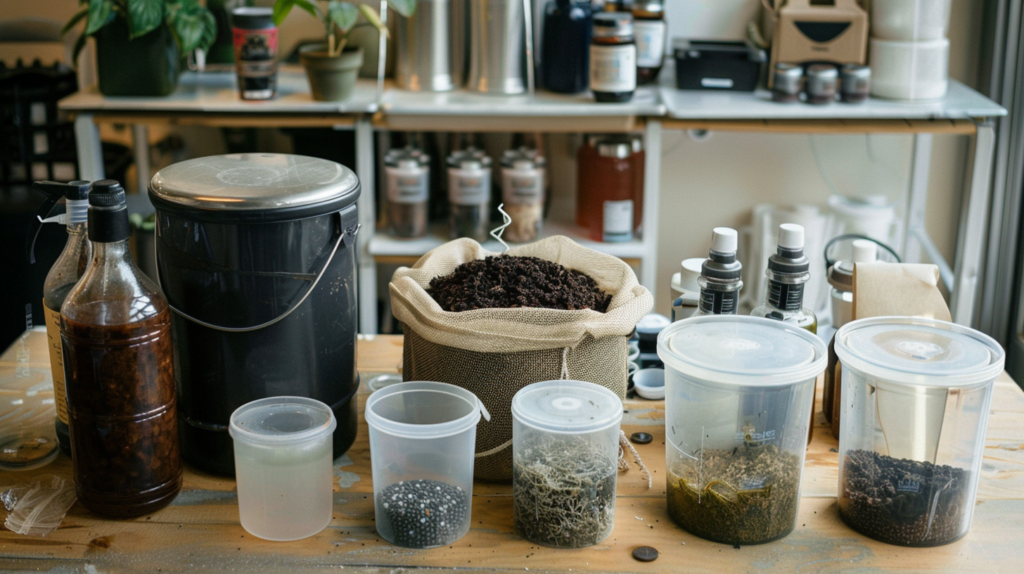
Compost tea, a nutrient-packed liquid concoction, is made from steeping composted organic materials. This brew is teeming with beneficial microbes and vital nutrients, acting as an organic fertilizer and a natural protector against diseases. In hydroponic gardens, compost tea plays a crucial role in enhancing plant vigor and health.
Definition and Composition of Compost Tea
Compost tea is crafted by brewing high-grade compost in water, a process that leaches beneficial microorganisms and soluble nutrients into the aqueous solution. The resulting brew is a complex mixture of bacteria, fungi, protozoa, and essential nutrients such as nitrogen, phosphorus, and potassium. The specific makeup of compost tea can vary based on the compost used and the brewing technique, but it generally includes:
- Bacteria: This group encompasses nitrogen-fixing bacteria, phosphate-solubilizing bacteria, and plant growth-promoting rhizobacteria (PGPR), all of which contribute to nutrient absorption, disease resistance, and enhanced plant health.
- Fungi: Beneficial fungi, including mycorrhizal fungi, assist in the efficient uptake of water and nutrients and provide protection against soil-borne diseases.
- Protozoa: These single-celled organisms are pivotal in managing bacterial populations and nutrient cycling through their feeding activities.
Beyond microorganisms, compost tea also contains a wealth of plant nutrients, including but not limited to nitrogen, phosphorus, potassium, calcium, magnesium, and various trace elements, all vital for plant development and health. The rich diversity and equilibrium of microbes and nutrients within compost tea underscore its value as an organic fertilizer and disease suppressant, fostering a sustainable and productive hydroponic ecosystem.
Beneficial Microorganisms and Nutrients Found in Compost Tea
Compost tea is an organic powerhouse, brimming with beneficial microorganisms and essential nutrients that synergistically enhance plant health and growth. This nutrient-rich brew harbors a variety of microbes, each contributing uniquely to the hydroponic system’s well-being. Key beneficial microorganisms in compost tea include:
- Plant Growth-Promoting Rhizobacteria (PGPR): These beneficial bacteria thrive in the root zone, boosting plant growth by fixing nitrogen, solubilizing phosphate, and synthesizing growth-promoting hormones.
- Mycorrhizal Fungi: Forming symbiotic relationships with plant roots, these fungi improve nutrient and water absorption, increase drought resilience, and guard against soil pathogens.
- Actinomycetes: These thread-like bacteria are adept at producing disease-suppressing antibiotics and enzymes, facilitating the breakdown of complex organics for easier nutrient uptake by plants.
- Protozoa: By preying on bacteria, protozoa help manage bacterial populations and release nutrients in forms readily accessible to plants.
Complementing these microorganisms, compost tea also delivers key plant nutrients, such as:
- Nitrogen: Essential for plant growth, chlorophyll synthesis, and overall vitality.
- Phosphorus: Critical for root development, energy transfer, and the formation of seeds.
- Potassium: Key to pest and disease resistance, water regulation, and general plant health.
- Trace Elements: Micronutrients, including iron, zinc, and manganese, are vital for plant metabolic functions.
The dynamic interplay between these microorganisms and nutrients in compost tea establishes a balanced, sustainable ecosystem within hydroponic systems. This organic methodology not only provides essential nourishment but also enhances disease resistance, optimizes nutrient absorption, and supports a vibrant, self-sustaining environment conducive to superior plant growth.
Advantages of Using Compost Tea in Hydroponics
The integration of compost tea into hydroponic gardens brings a multitude of benefits, enhancing plant health and boosting productivity. A key advantage is the infusion of beneficial microorganisms that foster plant growth, combat diseases, and facilitate nutrient absorption. These microorganisms collaborate to establish a balanced, autonomous ecosystem within the hydroponic environment.
Moreover, compost tea acts as a potent source of vital plant nutrients, such as nitrogen, phosphorus, potassium, and an array of micronutrients, all of which are in forms easily assimilated by plants. This ensures that plants receive the nourishment they need for vigorous growth and robust development.
Additionally, employing compost tea is a step towards sustainable agriculture. It diminishes the dependency on chemical fertilizers and champions a circular system that reduces waste and lessens the ecological footprint, aligning with eco-friendly gardening practices.
Step 2: Preparing Compost Tea
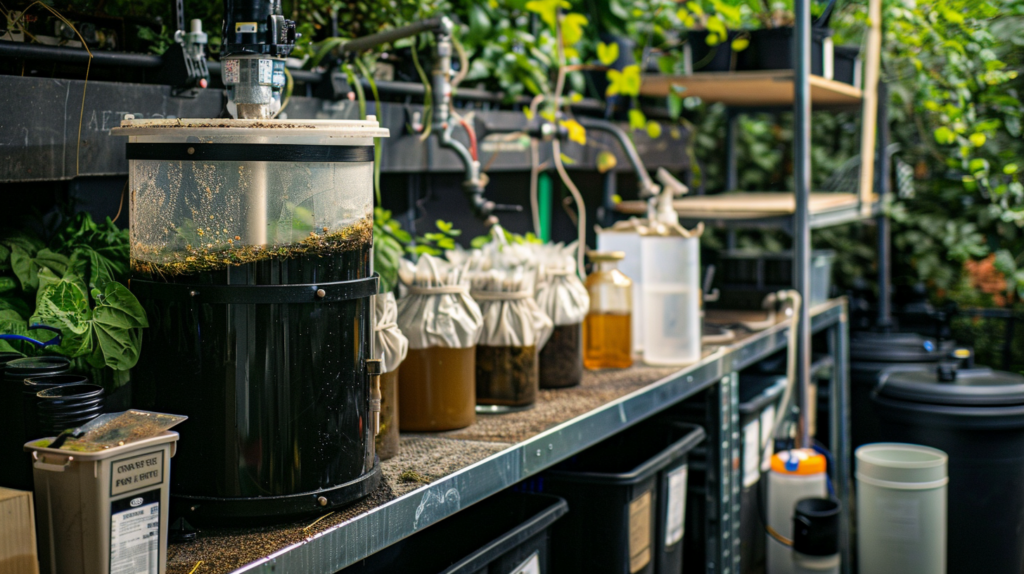
Creating compost tea involves a simple procedure, necessitating only a handful of key ingredients and tools. By adhering to the following steps, you can produce a nutrient-dense brew that will enrich your hydroponic plants and foster a vibrant ecosystem.
Ingredients and Equipment Needed
For crafting premium compost tea, certain essential ingredients and tools are required. The cornerstone of the brew is mature, high-nutrient compost, which can be sourced from your compost heap or a trusted vendor. It’s vital to ensure the compost is well-decomposed and devoid of any detrimental substances.
A brewing vessel is also necessary, such as a food-grade plastic bucket or a specialized compost tea brewer, which must be clean and equipped with a secure lid to preserve an oxygen-rich environment throughout the brewing period. To ensure sufficient oxygenation, vital for the proliferation of beneficial microbes, an air pump coupled with an air stone or diffuser is indispensable.
For containing the compost within the brewer, a mesh bag or a specific compost tea bag is recommended. Optional additives include molasses or similar sugar sources to nourish the microorganisms, and humic or fulvic acids to boost nutrient assimilation and plant development.
Step-by-Step Guide to Brewing Compost Tea
The process of brewing compost tea is uncomplicated and can be executed with ease when equipped with the proper ingredients and apparatus. Here’s a detailed guide to concocting a nutrient-rich elixir for your hydroponic flora:
- Prepare the Compost: Begin by enclosing the mature, premium compost in a mesh bag or a specialized compost tea bag, which will keep the solids contained while permitting the infusion of beneficial microbes and nutrients into the water.
- Fill the Brewing Container: Pour clean, dechlorinated water into your brewing vessel. The volume of water should correspond to the size of your container and the desired potency of the compost tea.
- Add the Compost Bag: Gently submerge the filled compost bag in the water within the container.
- Introduce Aeration: Attach the air pump to the air stone or diffuser and position it at the base of the container. Activate the air pump to ensure continuous aeration, fostering the growth of aerobic microorganisms.
- Optional Additives: If you choose, incorporate a modest quantity of molasses or another sugar source into the brew. These serve as sustenance for the microbes, enhancing their proliferation and activity.
- Brewing Duration: The brewing time will vary based on the desired intensity and concentration of the compost tea, with a typical range of 24 to 48 hours for optimal extraction.
- Maintain Aeration: Keep the air pump operational throughout the brewing to maintain sufficient oxygen levels, preventing the development of harmful anaerobic microbes.
- Remove the Compost Bag: After the brewing period, carefully extract the compost bag, allowing any residual liquid to drain into the brew.
- Dilute and Apply: The compost tea may need to be diluted with additional water before being introduced to your hydroponic system, depending on its concentration and your specific requirements. Adhere to the suggested dilution guidelines for your setup.
Ensure cleanliness during the brewing to avoid any contamination. It’s also crucial to utilize the fresh compost tea promptly, ideally within a few days, to capitalize on the active beneficial microorganisms and nutrients.
Tips for Maintaining Optimal Aeration and Brewing Time
Achieving high-quality compost tea hinges on proper aeration and the correct brewing duration. It’s essential to ensure that the air pump is in good working order and delivering consistent aeration throughout the brewing cycle. This continuous flow of air encourages the proliferation of beneficial aerobic microorganisms and wards off anaerobic conditions.
Furthermore, it’s important to stick to the suggested brewing period, which is generally between 24 to 48 hours. This timeframe allows for the thorough extraction of nutrients and microorganisms from the compost. Keep a close eye on the brewing activity and be prepared to adjust the process as necessary to uphold the ideal conditions for producing a compost tea that is both rich in nutrients and microbial diversity.
Step 3: Integrating Compost Tea into Your Hydroponic System

With a freshly brewed batch of compost tea at hand, the next phase is to seamlessly integrate it into your hydroponic system. This crucial step entails determining the correct dilution ratio for your tea, selecting an effective method of application, and setting an appropriate application schedule to ensure your plants receive the full benefits for enhanced growth.
Determining the Appropriate Dilution Ratio
The potency of compost tea can differ based on the brewing technique and compost origin, making it crucial to identify the correct dilution ratio for your hydroponic system. Applying a solution that’s too concentrated could harm your plants, whereas a too-diluted mixture might not deliver the needed nutrients and beneficial microbes.
To pinpoint the optimal dilution ratio, initiate a trial by mixing varying amounts of compost tea with water at different ratios, such as 1:10, 1:20, and 1:50. Monitor the growth and condition of several plants treated with each mixture over a certain period. The dilution that yields the best growth without adverse effects is likely the most suitable for your setup.
Also, take into account the developmental stage and size of your plants, along with the current nutrient concentration in your hydroponic solution. Seedlings and younger plants generally benefit from a weaker solution, whereas more mature plants can handle stronger concentrations. Continuous observation and fine-tuning are essential to achieve and sustain the perfect nutrient balance.
Methods of Applying Compost Tea to Hydroponic Systems
Incorporating compost tea into your hydroponic system can be achieved through various methods, each offering unique benefits. A popular technique involves adding the appropriately diluted compost tea directly to the nutrient solution reservoir. This approach ensures a steady distribution of nutrients and beneficial microbes as the solution circulates throughout the system.
Another effective method is foliar application, where compost tea is sprayed or misted onto the leaves and stems of plants. This technique aids in the foliar absorption of nutrients and introduces beneficial microbes to the plant surfaces, aiding in the prevention and management of leaf diseases.
For systems that utilize growing media or substrates, applying compost tea as a root or soil drench is advantageous. This ensures that the compost tea makes direct contact with the plant’s root zone, enhancing nutrient absorption and fostering a healthy root environment.
In larger hydroponic operations, setting up a dedicated compost tea injection system might be worthwhile. This system uses a separate reservoir and dosing pump to intermittently add compost tea to the main nutrient solution, tailored to the plants’ specific nutrient needs.
Whichever application method is selected, adhering to the recommended dilution ratios and application schedules for your particular hydroponic setup and plant species is crucial. Ongoing observation and adjustments are key to ensuring the maintenance of optimal nutrient levels and plant health.
Frequency and Timing of Compost Tea Applications
Determining the appropriate frequency and timing for applying compost tea to your hydroponic system is influenced by several factors, such as the plants’ growth phase, their nutrient demands, and the specific conditions of your system. It is commonly advised to administer compost tea weekly or bi-weekly throughout the peak growing season.
Nonetheless, you may need to modify this schedule in response to the plants’ growth behavior and nutrient levels. For instance, during intense growth spurts or fruiting stages, plants might benefit from more frequent compost tea applications. Additionally, it’s beneficial to align the timing of compost tea applications with the plants’ natural cycles of nutrient uptake to ensure maximum absorption and effectiveness.
Step 4: Monitoring and Adjusting

Once compost tea has been integrated into your hydroponic system, vigilant monitoring of plant health, growth, and nutrient concentrations becomes essential. Through consistent observation and timely adjustments, you can maintain peak system efficiency and preemptively tackle any emerging challenges.
Observing Plant Health and Growth After Compost Tea Application
Post-application of compost tea, it’s critical to meticulously observe your plants to confirm they are benefiting from the nutrient-rich addition. Key indicators to watch include the vibrancy of leaf coloration, the robustness of stems, and the general vitality of the plants. Optimal health is typically marked by lush green leaves, firm stems, and vigorous growth.
Be vigilant for signs of nutrient imbalances, such as unusual leaf discoloration, stunted growth, or other atypical symptoms. Should any issues arise, it’s imperative to adjust the nutrient mix or modify the compost tea dilution without delay. Moreover, tracking growth rates and crop yields is important, as compost tea often contributes to enhanced productivity.
Comparing your plants’ performance with past growth cycles or standard industry metrics can help evaluate the success of your compost tea applications. Consistent monitoring and recording are invaluable for refining your strategy and maximizing the advantages of compost tea in your hydroponic system and for your specific plant varieties.
Troubleshooting Common Issues and Adjusting Nutrient Levels
While the addition of compost tea to hydroponic systems brings a host of benefits, staying alert to potential problems is crucial. Nutrient imbalances are a frequent concern, potentially arising from overly concentrated compost tea or interactions with existing nutrients in the system. Symptoms of nutrient deficiencies, such as yellowing leaves or stunted growth, might necessitate adjustments in compost tea concentration or the addition of specific nutrients.
On the other hand, signs of nutrient excess, including leaf burn or plant wilting, may require diluting the compost tea or flushing the hydroponic system. Additionally, improper brewing or storage of compost tea could lead to the growth of undesirable microorganisms, manifesting as plant diseases or algal blooms. In such cases, discarding the compromised batch and implementing preventive measures, like enhancing aeration or modifying brew durations, is advisable.
Monitoring the pH and electrical conductivity (EC) levels is also vital, as these can be affected by compost tea. Adjustments might be needed to keep these parameters within the optimal range for your crops and growing conditions. Regular testing and meticulous record-keeping are essential for timely identification and correction of any issues.
For persistent problems or queries about nutrient adjustments, consulting with seasoned growers or turning to trusted resources is recommended for effective solutions.
Importance of Maintaining Proper pH and EC Levels
Ensuring the correct pH and electrical conductivity (EC) levels in your hydroponic system is essential, especially when incorporating compost tea. The pH level influences how plants access and absorb nutrients, while EC provides a measure of the solution’s total dissolved salts and nutrients. Deviations from the ideal ranges can result in nutrient imbalances, leading to deficiencies or toxicities and causing stress to plants.
To harness the full potential of compost tea and sustain a productive hydroponic garden, it’s imperative to regularly check and adjust the pH and EC levels. Keeping these parameters within the suitable range for your particular crops and growing conditions is key to fostering a healthy and flourishing hydroponic ecosystem.
Step 5: Complementary Practices

Although compost tea significantly benefits hydroponic systems, its effectiveness can be amplified through the integration of additional organic amendments and sustainable practices. These complementary strategies collectively contribute to establishing a harmonious and productive growing environment.
Incorporating Other Organic Amendments and Beneficial Microbes
Beyond compost tea, enriching your hydroponic system with a variety of organic amendments and beneficial microbes can further enhance plant health and growth. Elements such as humic and fulvic acids not only aid in nutrient absorption but also improve the structural integrity of the growing medium. Additionally, mycorrhizal fungi establish a symbiotic bond with plant roots, boosting their efficiency in nutrient and water uptake.
Incorporating organic inputs like kelp extracts, fish emulsions, and botanical fertilizers introduces a broad spectrum of nutrients and compounds that promote growth, working synergistically with compost tea to foster a balanced and eco-friendly hydroponic environment. The introduction of beneficial microorganisms, including Trichoderma species, offers further advantages by suppressing plant pathogens and enhancing growth. These beneficial microbes can be sourced from commercial products or other compost extracts.
Leveraging compost tea alongside these organic amendments and beneficial microbes cultivates a comprehensive and self-sustaining ecosystem, paving the way for unparalleled plant vitality and productivity.
Implementing Sustainable Practices in Hydroponic Systems
The integration of compost tea is merely one component of adopting sustainable practices within hydroponic systems. To truly enhance the ecological benefits and reduce environmental impact, it’s essential to engage in a broader spectrum of sustainable methods.
A pivotal aspect is the conservation and recycling of water. Although hydroponics is already more water-efficient than traditional soil farming, further reductions in water usage can be achieved through advanced irrigation techniques, reutilization of runoff water, and the implementation of rainwater harvesting.
Energy efficiency also plays a significant role in sustainable hydroponics. Consider harnessing renewable energy sources like solar or wind to operate pumps, lighting, and other hydroponic equipment. Fine-tuning lighting and climate control systems can also lead to reduced energy use without compromising the conditions needed for plant growth.
Effective waste management is another cornerstone of a sustainable hydroponic practice. Establish composting systems to process organic waste, which can then be transformed into rich compost for future compost tea batches. Moreover, seek ways to recycle or repurpose non-organic waste produced during the growing cycle.
By adopting these sustainable practices in conjunction with compost tea usage, you can cultivate a self-sufficient, environmentally friendly hydroponic system that conserves resources, minimizes waste, and fosters a more sustainable growing environment for plants and the community.
Exploring the Potential of Compost Tea in Different Hydroponic Setups
Compost tea’s adaptability makes it a valuable addition across a range of hydroponic systems, each with distinct features and needs. From deep water culture and nutrient film technique to ebb and flow or aeroponic systems, compost tea can enrich these setups with organic nutrients and beneficial microbes.
Tailoring the application methods, dilution ratios, and application schedules to suit the nuances of your hydroponic system can maximize the efficacy of compost tea. It’s also wise to assess how compost tea can synergize with other organic amendments and sustainable practices, fostering a comprehensive and flourishing hydroponic environment.
Conclusion
Integrating compost tea into your hydroponic system presents a sustainable and organic approach to boost plant growth, improve nutrient absorption, and achieve a harmonious ecosystem. By adhering to the guidelines provided in this guide, you can fully leverage the benefits of compost tea, elevating your hydroponic gardening endeavors to greater success.
Summary of the Benefits of Using Compost Tea in Hydroponics
The integration of compost tea into hydroponic systems yields an array of advantages that bolster plant health and enhance productivity. Compost tea infuses the growing environment with a rich diversity of beneficial microorganisms, such as bacteria, fungi, and protozoa. These organisms collaborate to establish a balanced, self-regulating ecosystem, essential for nutrient cycling, disease prevention, and stimulating plant growth.
Rich in vital plant nutrients including nitrogen, phosphorus, potassium, and a suite of micronutrients, compost tea ensures plants have access to the nutrients they need for optimal growth. The use of compost tea can also diminish the dependence on synthetic fertilizers and pesticides, supporting sustainable agriculture and reducing the ecological footprint.
Moreover, compost tea has been shown to bolster plant resilience, amplify yields, and elevate the quality of the harvest, affirming its value as an integral component of hydroponic gardening.
Encouragement to Experiment and Share Experiences with the Hydroponic Community
As you integrate compost tea into your hydroponic system, it’s important to adopt an experimental mindset and a commitment to ongoing learning. Given the uniqueness of each hydroponic setup and its specific environmental conditions, discovering the most effective use of compost tea may involve a process of trial and improvement. Feel free to tweak application frequencies, dilution ratios, and the integration of other sustainable practices based on the feedback you observe from your plants.
Furthermore, becoming an active participant in the hydroponic community can greatly enhance your journey. Sharing your own experiences and insights, as well as absorbing knowledge from other hydroponic enthusiasts, can be incredibly rewarding. Engage in online forums, attend relevant workshops, and collaborate with peers who are equally passionate about pioneering sustainable and innovative gardening methods. By pooling our collective experiences and discoveries, we can further explore the capabilities of compost tea and make significant contributions to the field of hydroponic farming.

